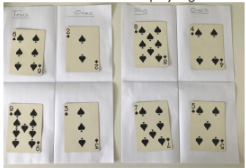Nice or nasty
Number Range:
Materials Needed:
Players:
Players use understanding of place value to compete against their partners to make the largest number using playing cards.

Purpose
- Practice place value
Materials
- Deck of playing cards
How to play: The nice version
- Learners work in pairs
- Give each pair of learners 9 cards (1,2,3,4,5,6,7,8,9). Shuffle the cards we and place them in between the learners.
- Each learners should take a piece of paper and fold it twice to make four blocks (see picture shown). Label one column tens and one column ones.
- Learner A takes the top card from the pile and can it in any one of his/her four blocks. Learner B takes the top card from the pile and can put it in any one of his/her four blocks. Learner A takes the top card from the pile and can put in anyone of his/her remaining empty blocks. Learner B takes the top card from the pile and can put it in anyone of his/her remaining empty blocks.

- Continue in this way until the blocks are filled.
- Now compare the numbers that have been made.
- So for example, in the game shown in the picture learners A made 62 and 93 and learner B made 84 and 75.
- Determine which is the biggest number that has been made (here it is 93). The learner who made that number gets a point.
The nasty version
The nasty version of the game is played in the same way except that each of the learners can put a card down in any empty block on their turn – even if that block is on their opponent’s paper. For example, if learner A picks up Ace (=) s/he could be nasty and put it in the column on opponent B’s paper. (It might be a good idea to let the child play the nasty version with an adult to avoid fighting)
Notes:
You can play this is a group, rather than in pairs. If played in a group then in the nasty version you can choose to put a card on anyone’s HTU columns.
Source:

